Nuggets of News Blog
|  |
Monday, October 19 2020
Are you excited about finding gold — ANY size gold? Most of us are, but if you want to sound like an old pro when referring to a 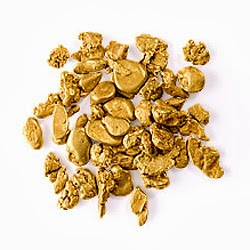 specific piece you find, check out the most common terminology: specific piece you find, check out the most common terminology:
Flour Gold: Gold particles that are barely visible to the naked eye. It’s so powdery, like flour, that it sometimes floats instead of sinks like heavier gold pieces.
Flake Gold: A piece of gold that is large enough to easily spot, but is difficult to pick up with your fingers. Use tweezers.
Fines: Particles of gold too small to pick up with your fingers. Combination of flake and flour gold.
Picker: A piece of visible gold large enough to easily pick up with your fingers.
Gold Nugget: Larger than a picker. A naturally formed lump of gold that is big enough to put in a poke and likely won't fit in a typical small vial, depending on its shape.
Specimen: A naturally formed large gold nugget or gold-laced quartz specimen.
Paydirt: Refers to dirt that has enough gold in it to be worth extracting. The term originated in the mid-1800 during the California Gold Rush. Today, you can even buy Alaska paydirt through the US Mail!
Concentrates: All the gold-bearing material left in your sluice or trommel, etc. after using your gold recovery equipment - usually black sand mixed with fine gold.
Fool’s Gold: The bane of any prospector’s existence! Iron or copper pyrites and mica can be mistaken for gold. The quickest and simplest test is to examine your sample in the shade, not in the sunlight. Real gold retains its yellow sheen even in shadow, whereas fool's gold does not. Real gold is soft and malleable; it can be cut with a knife and won't splinter. You can even "dent" it with a pin. Fool's gold, though, is hard and flaky. A drop of hydrochloric (muriatic) acid will tell you for sure. Real gold will not be affected, but if you see a slight foaming action and the sample begins to dissolve, you know it's not real gold.
Color: Slang for any amount or size of visible gold that you find in your gold pan.
Au: Gold is element 79 and its symbol is Au on the periodic table. As a pure metal, gold is extremely heavy with a specific gravity of 19.3, which means pure gold weighs 19 times more than an equal amount of water.
No matter what size or by what name, finding REAL GOLD is exciting! And there are many ways to go about it— start with your basic gold pan. Highbanking along a waterway is warmer and dryer than suction dredging. Drywashing out in the desert surrounded by sunshine and solitude definitely has appeal. And so does uncovering buried treasure and nuggets while metal detecting. Just keep in mind that once you do it a time or two, you’ll likely get gold fever! So what are you waiting for…. get out there and get your share of the GOLD!
Thursday, October 08 2020
Has Covid-19 put the kibosh on local haunted houses, trick-or-treating, and Halloween parties this year? Not to worry, you can still find some socially distant ghostly fun this season— visit a gold mining ghost town! About 3,800 ghost towns are still standing across the USA, mostly out West. Some of the buildings are in great condition, others are quite literally falling down. Some towns have become well-known, easy-to-reach roadside attractions, others are quite remote. Each town has its own boom-to-bust story that makes a visit both interesting and educational. Whether you’re a ghost hunter or a history buff, please leave everything as you find it. Take lots of photos, but no souvenirs.
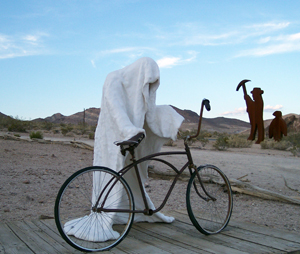 Rhyolite, Nevada. Winding throughout the rich and colorful Silver State, Nevada’s highways and byways are ideal for discovering America’s history. Route 374 is a prime example and leads to the much-photographed ghost town of Rhyolite. As far as boomtowns go, Rhyolite is a “newer” ghost town, having been born and busted between 1904 and 1920. What’s also special is that its crumbling yet photogenic buildings are mostly made of concrete, not wood. Since lumber was scarce in the desert, one creative miner even built his home out of mud and 30,000 assorted liquor bottles! But perhaps what is most unusual here is that you are guaranteed to see ghosts as you head into Rhyolite— yes, even in broad daylight! That’s because on the same gravel road heading toward Rhyolite, you’ll find a 15-acre outdoor sculpture park— Goldwell Open Air Museum. Among the unusual pieces of art are life-size ghosts, a 25-foot high pink woman made of cinder blocks, a 24-foot high steel prospector posing with a penguin, and much more. Rhyolite, Nevada. Winding throughout the rich and colorful Silver State, Nevada’s highways and byways are ideal for discovering America’s history. Route 374 is a prime example and leads to the much-photographed ghost town of Rhyolite. As far as boomtowns go, Rhyolite is a “newer” ghost town, having been born and busted between 1904 and 1920. What’s also special is that its crumbling yet photogenic buildings are mostly made of concrete, not wood. Since lumber was scarce in the desert, one creative miner even built his home out of mud and 30,000 assorted liquor bottles! But perhaps what is most unusual here is that you are guaranteed to see ghosts as you head into Rhyolite— yes, even in broad daylight! That’s because on the same gravel road heading toward Rhyolite, you’ll find a 15-acre outdoor sculpture park— Goldwell Open Air Museum. Among the unusual pieces of art are life-size ghosts, a 25-foot high pink woman made of cinder blocks, a 24-foot high steel prospector posing with a penguin, and much more.
Bodie State Historic Park, California. When a little girl writes in her diary “Goodbye God, I’m going to Bodie” you know her 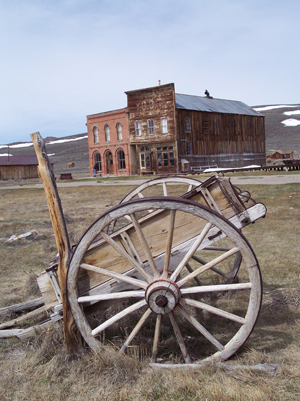 destination isn’t a pleasant one— not in the 1880s anyway when she penned that entry. The child’s name is unknown, but her words have became famous throughout the West to describe her family’s move to Bodie, California— once known as the Wildest Mining Camp in the West. From about 1877 through the 1880s, this gold mining town was booming and bustling. The population of miners, merchants, gamblers, entrepreneurs, and their families exceeded 10,000. Some people got rich. From the onset of mining through about 1941, the 30 different mining companies that operated in the Bodie Mining District produced close to $100 million in gold and silver (gold was then about $20 an ounce; silver was less than a dollar an ounce). The Standard Mine was the most profitable, yielding nearly $15 million over 25 years. It was actually this mine’s success that caused the 1878 rush to Bodie. Today, the lawlessness is long gone. Now a State Historic Park, Bodie is the nation's biggest unreconstructed ghost town, and provides an authentic look back into California’s mining history. What's left of Bodie—about 170 buildings and the Standard Mill— represents just five percent of what was standing in its heydey. There are no re-creations or restorations here. Everything is officially in a state of "arrested decay," meaning only minimal repairs are made on the remaining structures. destination isn’t a pleasant one— not in the 1880s anyway when she penned that entry. The child’s name is unknown, but her words have became famous throughout the West to describe her family’s move to Bodie, California— once known as the Wildest Mining Camp in the West. From about 1877 through the 1880s, this gold mining town was booming and bustling. The population of miners, merchants, gamblers, entrepreneurs, and their families exceeded 10,000. Some people got rich. From the onset of mining through about 1941, the 30 different mining companies that operated in the Bodie Mining District produced close to $100 million in gold and silver (gold was then about $20 an ounce; silver was less than a dollar an ounce). The Standard Mine was the most profitable, yielding nearly $15 million over 25 years. It was actually this mine’s success that caused the 1878 rush to Bodie. Today, the lawlessness is long gone. Now a State Historic Park, Bodie is the nation's biggest unreconstructed ghost town, and provides an authentic look back into California’s mining history. What's left of Bodie—about 170 buildings and the Standard Mill— represents just five percent of what was standing in its heydey. There are no re-creations or restorations here. Everything is officially in a state of "arrested decay," meaning only minimal repairs are made on the remaining structures.
Oatman, Arizona. If you’re out to get some kicks on historic Route 66, stop in the ghost town of Oatman, Arizona. Born as a tent camp for gold miners in 1906, the town boomed, then busted in the 1940s, and has since come alive again. Over half a million tourists visit Oatman each year, greeted by friendly resident burros looking for a carrot snack! Although there are gift shops, staged gunfights, and costumed entertainers strolling the streets, Oatman takes pride in keeping the flavor of the town as authentic as possible. You won’t find newly renovated buildings here—Oatman’s historic buildings are definitely from a bygone era. As you stroll through town, watch for signs and painted murals. One particular interesting sign shares the history of the Oatman name. It was originally named Vivian, after the Vivian Mining Company. It was later renamed Oatman in honor of Olive Oatman, a woman kidnapped by Indians in the 1850s, and released five years later for a ransom of one horse, four blankets, and some beads. Signs also tell you that the town appeared in several movies such as How The West Was Won, Foxfire and Edge of Eternity.
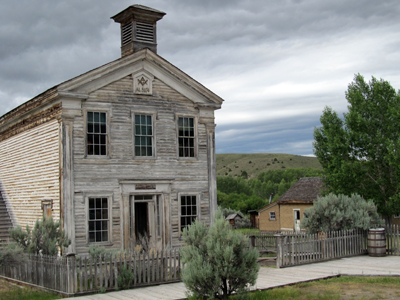
Bannack State Park, Montana. Although the old-time prospectors are long gone, many mining relics and over 60 buildings remain at Montana’s Bannack State Park. Most are so well preserved that you can actually go inside them— a rare treat when it comes to ghost gowns. Bannack’s rich history began 150 years ago with John White’s discovery of placer gold along the banks of Grasshopper Creek. In July 1862, Mr. White filed one of the first recorded mining claims in what was later to become the state of Montana. Good news traveled fast and by fall of that year, “Grasshoper Diggins” was home to 400 prospectors. By the following spring, the population had swelled to 3,000 — the Gold Rush was definitely on! On the southeast end of Bannack, the Bessette House is believed to be haunted by the children who died here during an epidemic of scarlet fever. The site is nicknamed the Crying Baby House because of the sounds some visitors have reported hearing.
Keep the old timers in mind as you stroll through these or any other gold mining ghost town. It will give you a new appreciation for modern gold mining equipment and metal detectors that makes gold recovery so much quicker and easier. It really puts into perspective yesteryear’s impact on the gold mining we do today. Find more information on ghost towns, gold mine tours, and travel articles on historic sites here.
Sunday, September 13 2020
The most basic piece of prospecting equipment is the gold pan. Size, color, and shape are really a matter of personal preference. Plastic pans generally come in green, black, and blue. The color doesn't effect performance, but green is the most common. Plastic is light weight, so when you add water, dirt, and gravel to your pan, your arms won't get as tired compared to using a steel pan. It's good to have a couple different sizes of gold pans on hand (10 inch, 12 inch, and 14 inch are the most popular). 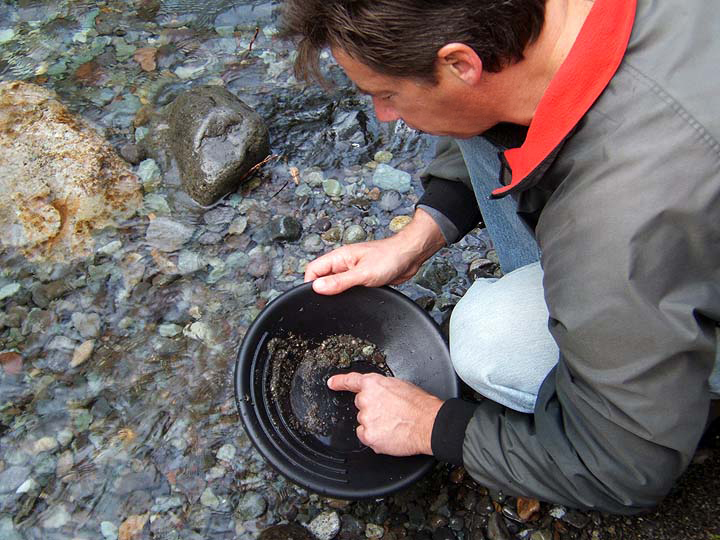
Before you add a new pan to your collection, be sure to “condition” or “season” it for best results. The goal is to remove some of the oils that were used in the plastic mold when the pan was produced. These oils will make your pan too slick, and without some friction you may wash out the gold with the waste material. You’ll want to rough up the bottom and sides of the pan a little to get that all-important friction.
To season a new gold pan in three easy steps, you will need some dish soap that cuts through grease (i.e., Dawn), a scrubby pad, sand, and some water.
1. Add a squirt of dish soap and water to the new pan. Scrub the pan with the scrubbing pad— get all the ridges and every inch of the bottom and sides.
2. Dump a scoop of sand into the pan. You just need enough to scratch up the pan a bit. Again, scrub the sand over the ridges and entire bottom and sides of the pan back in forth in different directions.
3. Rinse your pan, dry it, and have a look. If you see any shiny or glossy areas, repeat the steps from above.
Now you’re ready to use your new pan! If you’re just getting started, try these gold panning techniques:
1. Fill pan about half full of gravel, small rocks, and sand collected from the stream bed
2. Put the pan under the water's surface, break up large lumps of clay or dirt, and remove stones
3. Continue to hold the pan level under the water with your hands on opposite sides, and tilt the pan forward, away from your body, and down slightly. Rotate and shake it side to side to let gravel and sand dribble out the front. Pick out the rocks.
4. Repeat step 3 several times until most of the material is removed, leaving less than a cup of fine-grained dark material overlain with a thin layer of light material at the bottom of your pan.
5. Rotate the pan in a circular motion. Notice how the water separates lighter material from heavier.
6. Stop rotating and hopefully you'll see a flash in the dark material remaining in the bottom of your pan! Use tweezers to retrieve the gold and place in a vial for safe-keeping.
Practice makes perfect, and hopefully before long you’ll be yelling EUREKA when you spot the shiny stuff in your new pan! Gold pans and gold panning kits found here.
Saturday, August 01 2020
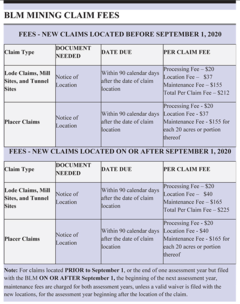 Mining claimants who wish to retain their mining claims on Bureau of Land Management and Forest Service lands through the 2021 assessment year must pay a maintenance fee or file a maintenance fee waiver certificate on or before September 1, 2020, to prevent the mining claim from being forfeited. Mining claimants who wish to retain their mining claims on Bureau of Land Management and Forest Service lands through the 2021 assessment year must pay a maintenance fee or file a maintenance fee waiver certificate on or before September 1, 2020, to prevent the mining claim from being forfeited.
The maintenance fee for an existing lode claim, tunnel site, or mill site will increase to $165 on September 1, 2020. For placer mining claims only, the fees will be $165 for every 20 acres of land or portion thereof. Miners who file a Small Miner’s Waiver on or before September 1 will be required to file an Affidavit of Assessment Work Form on or before December 30, 2020, including the $15 processing fee per claim.
Each payment must be accompanied by a written list of the claim names and BLM serial numbers for which the maintenance fee is being paid. You can find your state BLM office at www.blm.gov.
Please note that new mining claims filed on or after September 1, 2020, will be subject to the new fee schedule.
It's highly recommended that you send your documents by registered mail or hand deliver them while retaining copies for your records.
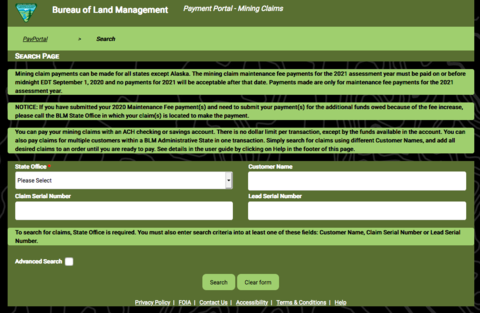 Claimants in all states except Alaska may pay their annual maintenance fee online through the Mining Claim Maintenance Fee Payment Portal found at https://payp.blm.gov/eppcore/home. You can pay your fees with an ACH checking or savings account. There is no dollar limit per transaction, except by the funds available in the account. You can also pay claims for multiple customers within a BLM Administrative State in one transaction. Simply search for claims using different customer names, and add all desired claims to an order until you are ready to pay. Claimants in all states except Alaska may pay their annual maintenance fee online through the Mining Claim Maintenance Fee Payment Portal found at https://payp.blm.gov/eppcore/home. You can pay your fees with an ACH checking or savings account. There is no dollar limit per transaction, except by the funds available in the account. You can also pay claims for multiple customers within a BLM Administrative State in one transaction. Simply search for claims using different customer names, and add all desired claims to an order until you are ready to pay.
When you get to the claim search page, select the state where your claims are located and enter either the last name of the claimant, the claim serial number, or the lead serial number to search for your claim.
Claimants who file on paper must include a document listing the claim/site name(s) and the BLM serial number(s) assigned to each claim for which the fees are being paid.
Do not forget to file new claim forms or affidavits of assessment with your county recorder as well.
Tuesday, June 23 2020
Ocean beaches can be compared to the Mother Lode. Why? Because you can find GOLD on many by mining with a highbanker, and by searching with a metal detector. How lucky is that?! TWO ways to find gold at the same location! Think about it, who hasn’t lost a ring or coins at the beach? Whether you prefer recovering gold by swinging a detector or shoveling into a high banker, your chances of both are higher by visiting a beach this summer that is located in a gold-bearing area. A side benefit is that you’re enjoying the nice weather while it lasts while mining the beaches in different ways.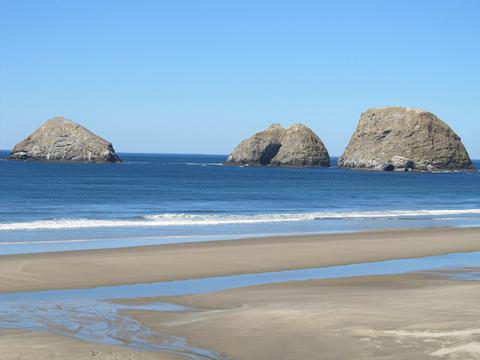
Beach Mining with a Highbanker
When you consider the advantages of beach mining with a highbanker— easy access in all seasons, no classifying material down to size, no digging in heavy cobbles and moving boulders, no worries about rattlesnakes or poison oak— the idea is very appealing. Of course any new environment means there will be a learning curve. Recovering 100 mesh gold from the beach requires a little extra attention to detail to prevent loss, so you’ll need to readjust your equipment and process. Don’t expect chunky nuggets; you’re going for the flour gold here. High tide, not your watch, will dictate your schedule. The general principles you already know are the same, but also keep these tips in mind.
• Slow down. Expect to process about 10 gallons of material an hour. If you try to feed a highbanker faster or use bigger scoops you will likely lose gold. The most efficient way to locate the paying black sand layers is to use a post hole digger or earth auger. The pay layer is usually right on top of a golden brown sand layer that pushes up into the black or blue sand. Frequent storms can remove the light sands and reconcentrate the black sands.
• Use about 25% of the water you would normally use. You may need to modify your spray bar to compensate for less water volume so you aren’t fighting foam and bubbles.
• The beach is a level playing field—literally, so tip your box to a 9-degree angle and go from there. Most beach miners use battery-powered bilge pumps to run their beach sluices. A small gas-powered pump also will work. A Gold Cube is also an excellent piece of recovery equipment to concentrate beach material, then run it through a Blue Bowl.
• Do frequent clean-ups.
Beach Mining with a Metal Detector
Water and sunscreen have a sneaky way of slipping rings from fingers of swimmers and sunbathers, making beaches a lucrative location for metal detecting. There are actually several similarities between beach hunting for jewelry and hunting for gold in the rivers. At the beach, stuff that is lost in the upper sand areas make their way down into the surf during large storm events just like gold is washed downstream in the same storms. You can find an occasional nugget above a river in gold country, but you’re going to make your best finds when you locate the pay streak where nature has concentrated the gold. The same is true of the beaches.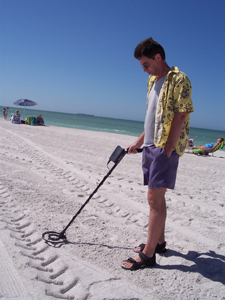
You will find that the surf sorts out materials, and when you are really lucky, you can identify a pay streak. In a river, the gold pay streaks follow the downstream flow of the river, but on the beach the pay streak will typically run horizontal across the beach. After items have been in the sand/surf for some time, the wave and current action tend to sort thing by weight and density. The pull tabs will be in a certain line, the lighter coins further down towards the deeper water, and when you start detecting fishing weights, you are likely nearing a pay streak. That is where you are most likely to strike gold— as in gold rings, bracelets, pendants, etc.
Wet sandy areas are particularly lucrative for detectorists. The reason for this is that beach-goers first congregate at the "towel line" and then migrate to wet sand. The "towel line" is an invisible area where the majority of people plop down their towels and coolers and umbrellas. At the towel line, sunbathers slather on slippery sunblock and tanning oil that acts like a lubricant and lessens friction. After baking in the sun for a while, they will need to go into the water to cool off a bit, which is where the body's natural reaction to cold is to shrivel up. Less friction + shrinkage = rings in the wet sand you can find with your metal detector!
In all types of beach hunting, the discrimination must be kept very low, eliminating only small iron (bobby pins and nails). Aluminum pull tabs and tin foil should not be discriminated or you will lose some gold and/or platinum rings as well. Some beach hunters operate with zero discrimination and dig everything. Use of a sand scoop makes target recovery fast and easy. It’s important to realize that most gold rings will read in the “middle” tones (above iron but below coins). If you’ve ever hunted the beach you have no doubt found your share of unwanted nails and other litter. To solve this, lace a rare earth magnet in the scoop to quickly capture those small, annoying iron targets. If you’re going to hunt the salt beach areas, you’ll want to get a heavy duty plastic scoop. A steel scoop will rust fairly quickly in those harsh conditions.
If you intend to hunt IN the water, of course you will need a waterproof metal detector and waterproof headphones — one that can handle salt water mineralization. There are some good pulse induction machines that work extremely well in salt conditions. Very shallow water is no problem but when you hunt waist deep water and deeper you should consider a mask and snorkel. If possible, hunt at low tide. That way you can get further out and hunt where other detectorists might not have gone. Plus, the surf tends to pull things down the beach and out into deeper water.
It goes without saying you should check your local laws first to see if you need a beach mining permit. Some state park beaches don’t allow metal detectors either, so double check the rules. Good luck and have fun mining the surf and sand… and remember to wear sunscreen and stay hydrated!
Saturday, May 02 2020
Researching new areas in which to prospect for gold, gems, or whatever you are seeking can be a lot of work, but since we’re now 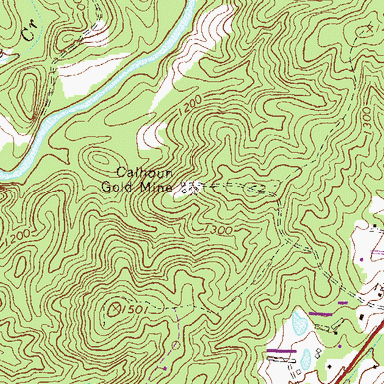 about six weeks into the Coronavirus quarantine, most of us have extra time that could be put to good use. Even though you may not be out in the field every day, you can still be prospecting! And even if you’re not making plans for out-of-state road trips just yet, you can still dig down into the history of local areas for new ideas. In other words, use your downtime wisely, so you can hit the ground running with your gold pan, highbanker, pick and shovel, metal detector, or other equipment as soon as shelter-in-place restrictions are lifted. about six weeks into the Coronavirus quarantine, most of us have extra time that could be put to good use. Even though you may not be out in the field every day, you can still be prospecting! And even if you’re not making plans for out-of-state road trips just yet, you can still dig down into the history of local areas for new ideas. In other words, use your downtime wisely, so you can hit the ground running with your gold pan, highbanker, pick and shovel, metal detector, or other equipment as soon as shelter-in-place restrictions are lifted.
As you begin researching, don’t rely on just one source of information. Confirm it through several sources. The best kind of research brings together different forms of info from a multitude of sources. It is the info gleaned from COMBINED sources that can help you to determine the best possible place to locate precious metal or gems. The more info you can lay your hands on, the better. Consider these resources:
- Old mining district reports and mining history books. Most western states have some form of mining and geology agency, although they all have different names depending on the state. Find out what information is publicly available at the agencies located in the area you will want to prospect. Old history books can be more help than any state agency because they were written by folks with ties to the area they wrote about. That means they often include valuable information on old mining discoveries or operations that didn’t make it into a government report.
- LR2000. Utilize the Bureau of Land Management’s Legacy Rehost System, LR2000, for information on mineral development, mining claims, classifications, and more on federal lands. After all, you don’t want to accidentally claim jump or waste time if an area is closed.
- Topographic maps. Many old mining areas are shown on topo maps, but usually not on the newer versions, so try and find older topo maps. Many of the newer versions may have old mines removed as a way for the government to “keep the general public safe” by not advertising the whereabouts of the old and “dangerous” mine shafts.
- Aerial photos. Google Earth is amazing in its quality and detail of photos. Many times you can see individual trees, hiking trails, rock outcrops and even hand-stacked piles of rocks left behind by old-timers. Sometimes larger features and patterns (areas where miners removed a lot of brush, for example) cannot be seen from ground level, but are obvious from far up in the sky. This is also a good way to get an idea of the condition of the roads in the area so you’ll know in advance which look to be commonly traveled. Google Earth ties in with GPS, too. You can review the photos, check them against maps, and get the GPS coordinates of the precise location you want to visit. You will then know for sure that you are in the right spot once you travel there.
- Reference libraries. The librarians at state mining divisions and university libraries are generally very friendly and helpful. These libraries are open to the public, so don’t feel shy about requesting help. Any university with a good-sized geology or mining program should have quite a few geologic reference resources including old reports, magazines on the mining industry, thesis reports by graduate students, and even reports by engineers and geologists who were on site at the big operating gold mines in the late 1800s. Many of the old books and reports found in the university libraries will be out of print and cannot be purchased anywhere, so be sure to make photocopies of any documents you need while you are onsite.
If you are a member of Gold Prospectors of America (GPAA), know that claims are still open as of May 2020. GPAA Claims are located on federal BLM and USFS land. At this time, only developed property and campgrounds have been closed in certain states. Access to GPAA claims has not been impacted, and if your local guidelines permit, you are free to continue prospecting as long as you are following the CDC guidelines to slow the spread of the virus. This includes practicing social distancing, and not being in groups of more than 10 people.
Although COVID-19 has changed the world as we know it, chances are good that as a prospector you PREFER social distancing. And what better way to enjoy solitude than out in nature armed with some new knowledge gleaned through research that can make your mining efforts more profitable. It’s no surprise that when the economy takes a turn for the worse, the price of gold (and many other precious metals and minerals) usually reach new highs. And every time the price of gold starts to climb, recreational prospectors get a bit more motivated to seek out hidden fortunes. Many people might get discouraged by the amount of work and time that can be involved in researching new areas, but when you find a new spot with good gold, it will be well worth your time and effort. Good luck and stay safe!
Tuesday, March 31 2020
Although “social distancing” has become part of everyone’s new normal, gold prospectors and metal detectorists have traditionally  separated themselves from the masses. Sometimes it’s because we want to keep our secret spot a secret. Sometimes it’s because spouses and friends don’t share our same passion. Sometimes we just need some alone time with Mother Nature to decompress from the modern world. It has been this way for generations, and most likely will continue. When you think about it, metal detecting is the most solitary form of prospecting, even if you are out with a group of friends. A detectorist knows that distance from others is a vital part of detecting. Detectors hear each other, and there is nothing worse than missing a target because of interference from another detector. As a detectorist, we know this and keep our distance for everyone’s success. It is something that we do without thought. A treasure hunter’s appreciation for being outdoors truly allows us to live in the moment when there is color in the pan or while digging a nugget. That being said, we are also not your stereotypical loner aimlessly wandering with only a faithful dog by our sides. Today’s prospectors are socially skilled and adept at working together, or alone, to get the gold. Most are willing to share our lifestyle with anyone that asks. separated themselves from the masses. Sometimes it’s because we want to keep our secret spot a secret. Sometimes it’s because spouses and friends don’t share our same passion. Sometimes we just need some alone time with Mother Nature to decompress from the modern world. It has been this way for generations, and most likely will continue. When you think about it, metal detecting is the most solitary form of prospecting, even if you are out with a group of friends. A detectorist knows that distance from others is a vital part of detecting. Detectors hear each other, and there is nothing worse than missing a target because of interference from another detector. As a detectorist, we know this and keep our distance for everyone’s success. It is something that we do without thought. A treasure hunter’s appreciation for being outdoors truly allows us to live in the moment when there is color in the pan or while digging a nugget. That being said, we are also not your stereotypical loner aimlessly wandering with only a faithful dog by our sides. Today’s prospectors are socially skilled and adept at working together, or alone, to get the gold. Most are willing to share our lifestyle with anyone that asks.
Our biggest challenges out in the field, which get easier over time with experience and using new equipment and technology, are learning to read the ground and waterways, and then recovering the gold when we find it. However, this year we face a different challenge with COVID-19, the novel 2019 coronavirus. COVID is more infectious than the flu and the chances of spreading the virus is much greater than spreading the flu. How does this impact us in our quest for the yellow metal? Should we give up one of our favorite pastimes, hobby, or small business? Although each person needs to make their own informed decision, most would say NO. Undeterred, we should continue to head out into the woods or desert (wear snake protection!) where we are many times safer than in the social situations that surround us daily.
Depending on our age and general health, some of us might already face a higher than average risk of having a serious medical issue no matter what we are doing or where we are doing it. Many people already deal with high blood pressure, diabetes, heart disease, arthritis, cancer, and more. Not that we can compare these more common maladies to the COVID-19 Pandemic, but the point is that many are already used to taking precautions and living with risks. Folks with existing health conditions have been taking the necessary self-care steps for years, especially when out in the field and far away from a city. How do you protect yourself and others and help flatten the curve until the pandemic is no more? If you want to continue to prospect on a claim, sluice on a waterway, swing a detector, and enjoy the great outdoors this spring and summer, consider these easy tips before you head out:
- Fix your own food and drink. Since you do not have control of how others prepare and serve food (and most eateries are closed anyway), take control of what you eat and drink. When is the last time you enjoyed a home-made PB&J or tuna sandwich? Pack your own, and take along packaged jerky and chips and candy. Wipe down packages with a sanitizing wipe. Bring your own bottled water, coffee in a thermos, or something stronger for enjoying around a campfire if you’re spending the night.
- Carry sanitizing wipes and or hand sanitizer. In case you can’t find any in the stores right now, make your own reusable wipes with microfiber cloths, aloe vera gel, 91% alcohol, a couple of drops of soap and vinegar. Use your sanitizer after contact with anyone or anything, including pump handles, keypads, money, credit cards, etc. There is nothing wrong with not shaking hands when you meet someone. And if you do shake, sanitize. It’s not rude to protect yourself.
- Wash your hands often and completely. You’ve heard it a million times since childhood, and the advice has never been more prudent than right now.
- Do not touch your face. This is one of the easiest ways to transmit outside germs and pathogens into your body, so become aware of how often you touch your face and try hard to change this habit.
- Don’t fret. Go through the season knowing you’ve done the very best to protect yourself and others. Enjoy your trip knowing you have everything you need— food, water, piece of mind, and distance—and enjoy the hunt for the gold. Say to yourself “I’m here and nothing else matters right now. I am where I belong.”
Of course, commonsense also tells us that if you feel symptomatic or think you may have been exposed, immediately follow the current COVID-19 health care guidelines. Otherwise, hopefully digging in the dirt will provide you with a level of normality that we would not otherwise have if we stayed at home listening to the news 24/7. Start planning your next prospecting trip and take advantage of the greatest social distancing project out there! One that has been around since the time man first found gold centuries ago. And what’s better is that social distancing by prospectors is not driven by fear, but by the excitement of getting out there and hunting for gold! Good luck and be safe!
Tuesday, February 11 2020
The big gold rushes of the 19th century have long since ended, but in most cases you can still prospect for the precious metal in these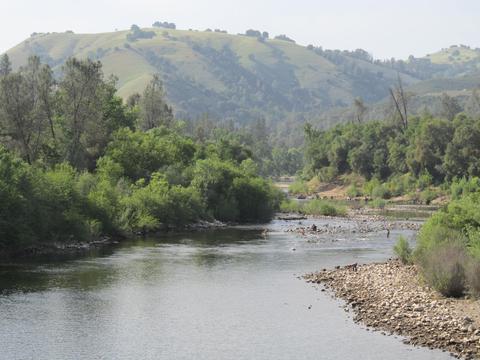 same historic areas. If you’re interested in giving recreational gold mining a try but not sure where to go, below are some key locations where you can still find the yellow metal by gold panning or metal detecting. Since gold was found in these areas, likely the old-timers didn’t get it all— so you may get lucky and strike it rich (or at least catch gold fever)! Rules and regulations differ from state to state, so always be aware of the local laws. And if you want to metal detect on private land, you’ll need permission from the landowner. same historic areas. If you’re interested in giving recreational gold mining a try but not sure where to go, below are some key locations where you can still find the yellow metal by gold panning or metal detecting. Since gold was found in these areas, likely the old-timers didn’t get it all— so you may get lucky and strike it rich (or at least catch gold fever)! Rules and regulations differ from state to state, so always be aware of the local laws. And if you want to metal detect on private land, you’ll need permission from the landowner.
Below is a very short list that offers a few ideas only. Beginners should search the internet or join a local gold prospecting organization for more information.
Crow Creek, Alaska. If you are heading to the 49th state and want to look for more than just incredible scenery and wildlife, you might want to try your hand at panning for gold in Crow Creek. The first claims of gold are said to have been made in 1897 near the mouth of the stream. The discovery of gold near the Chena River in Fairbanks set off the Fairbanks Gold Rush of the early 1900s and gold is still found in relatively impressive quantities in Alaska's ice-cold waterways. Recreational panning is also allowed at the narrower Pedro Creek to the north of Fairbanks. If a trip is not in your immediate plans, you can still have gold-rich paydirt sent directly to your home where you can pan in a tub in your kitchen sink!
American River, California. The California Gold Rush began in 1848 when gold was discovered at Sutter's Mill on the banks of the American River in Coloma. The surrounding area is still rich in gold deposits, and recreational panning is permitted these days at the south fork of the river in Coloma and at two forks in the Auburn State Recreational Area. The Cosumnes River that flows through California's Eldorado National Forest is also known for its golden deposits, and several campgrounds are nearby. There are many places to hunt for gold in California. Just read up on its rich gold mining history for more ideas on where to go.
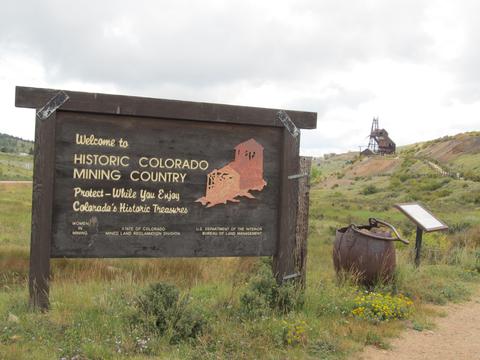 Clear Creek, Colorado. A gold-hunter's paradise, this river in Colorado is hands-down the best place in the state for recreational prospecting. Panning and sluicing for gold is permitted on the river bed at Arapahoe Bar in west Denver, and digging is allowed on the north side of the river there. There's also a large stretch of river about 10 miles upstream from Arapahoe Bar at Clear Creek Canyon where gold panning and sluicing are permitted. You may even have better luck here since the location is up-river. Clear Creek, Colorado. A gold-hunter's paradise, this river in Colorado is hands-down the best place in the state for recreational prospecting. Panning and sluicing for gold is permitted on the river bed at Arapahoe Bar in west Denver, and digging is allowed on the north side of the river there. There's also a large stretch of river about 10 miles upstream from Arapahoe Bar at Clear Creek Canyon where gold panning and sluicing are permitted. You may even have better luck here since the location is up-river.
Snake River, Idaho. Gold has been found throughout most of the 800-mile length of the Snake River from the headwaters near Yellowstone National Park to Lewiston, Idaho. In 1860 the Idaho Gold Rush began. It started with a gold discovery in Pierce, particularly at the juncture where Orofino Creek meets Canal Creek. The most popular gold- producing district in Idaho is Boise Basin County, which was discovered only two years after the Pierce event took place. It has also been reported that gold was discovered in Pend d'Oreille River in 1852.
Rye Patch, Nevada. Northern Nevada is home to the state's best known placer field for nugget shooting with a metal detector— the Majuba or Rye Patch placer district. The area is located west of the Rye Patch Reservoir, about 45 miles north of Lovelock. Despite intensive prospecting in this region beginning in the 1860's, this placer field was not discovered until 1938 by a local man who worked the area by drywashing for several years through the early 1940's, producing over 600 ounces of placer gold. Sporadic prospecting work has continued ever since.
Little Meadow Creek, North Carolina. Little Meadow Creek at Reed Gold Mine, is the site of the first discovery of gold in the United States. In 1799, Conrad Reed was walking along Little Meadow Creek when he noticed a shiny, gold substance in the water. It turned out to be a 17 pound gold nugget! Since then, deposits were mined in both the Piedmont and Mountain regions, most of the early production was in the central Piedmont, particularly in the Carolina slate belt and in Mecklenburg County.
Black Hills Forest, South Dakota. In 1876 the gold rush swept across the Black Hills of South Dakota after gold deposits were found in Deadwood Creek, and folks have been panning for gold ever since. Strawberry and Elk creeks all have placer gold, as well as Yellow, Squaw and Annie creeks. Generally, most of the National Forests are open to recreational mineral and rock collecting, gold panning and prospecting using a metal detector. But always check local regulations because some wilderness areas are closed to treasure hunting of any kind.
Keep in mind that even if there has been no major “rush,” major amounts of gold have been found in many other states, too, including Georgia, Michigan, Montana, New Mexico, Oregon, South Carolina, Tennessee, Texas, Utah, Virginia, Washington, Wisconsin, and Wyoming. Good luck!
More articles on gold mining history found here.
Thursday, January 30 2020
Anyone who prospects for gold knows how elusive it can be. Even when you’re for certain on “good ground,” you can end the day with not much to show for your efforts. On the other hand, you may have a really great day and recover some of the shiny stuff, only to return to the same spot at a later date and find nothing. Often, the amount of gold you recover changes when you use a different piece of equipment or a different accessory. Sometimes it’s the weather that exposes or releases gold after a flood or storm. The environment can change, but sometimes the positive difference can be new places to look for gold. Besides hiding in the usual places in streams and on dry land— in crevices, behind boulders, in the roots of plants and trees, in tailings piles — have you ever considered looking for gold in MOSS? Yes, the kind of ordinary moss that thrives in wet conditions!
Mosses are small flowerless plants that usually grow in dense green clumps in shady moist places. That might be the forest floor, or on trees and rocks along the banks of a waterway. Moss is seedless and only grows roots shallow enough to attach itself to surfaces where it will thrive. Moss doesn’t have a root like a flower has, but it does have root-like structures that attach it to the host rock. These structures are known as rhizoids. Instead of sucking up moisture through the roots, moss collects rain and stream water that runs over top of them. It may also collect fine gold in the same way.
If you’ve visited a particular stream at various times of the year, you know that water levels can vary greatly. Sometimes water completely covers mossy rocks that are along the banks, other times when the water level is low, the moss is exposed and dries out in the sun. Have you ever considered processing that ordinary moss for fine gold? It doesn’t sound too crazy when you think about gold being heavier than water and how it hides under boulders and rocks. So why couldn’t fine gold collect in moss as well? The next time you see moss growing along a gold-bearing waterway, try processing that moss (and all the dirt and sand and — hopefully — GOLD) that is mixed in with it. If you don’t have a convenient gold vacuum such as a Vac Pac, try scraping the moss into a bucket. Then break it up to release the dirt from the roots. Once you work the dirt and sand out of the moss, pan that material. Depending on the number of rocks located along any given waterway, you may find plenty of moss to work in addition to sluicing or panning in that river. Give it a try. You may just recover some of that elusive gold that would ordinarily gets overlooked by most prospectors. Good luck!
Monday, January 20 2020
The 2020 GPAA Gold & Treasure Show circuit is planned to be better than ever this year! With $110,000 in prizes, several dozen vendors demonstrating equipment, informative 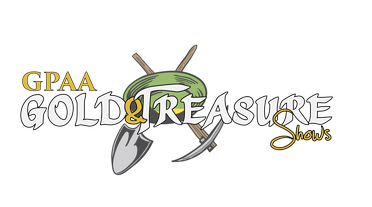 seminars, and 100 feet of gold panning troughs salted with real gold (keep all you find!), you won’t want to miss bringing the family to a weekend show sponsored by Gold Prospectors Association of Amercia. Eleven shows are to be held across the country in 2020. seminars, and 100 feet of gold panning troughs salted with real gold (keep all you find!), you won’t want to miss bringing the family to a weekend show sponsored by Gold Prospectors Association of Amercia. Eleven shows are to be held across the country in 2020.
Saturday show hours 10 am - 5 pm and Sundays 10 am - 4 pm in these cities:
• Pomona, CA: February 15-16
• Albuquerque, NM: February 29-March 1
• Phoenix, AZ: March 7-8
• Vancouver, WA: March 21-22 CANCELLED DUE TO COVID-19
• Sacramento, CA: March 14-15 CANCELLED DUE TO COVID-19
• Butte, MT: April 4-5
• Concord, NC: April 25-26
• Rapid City, SD: April 18-19
• Columbus, OH: May 2-3
• Milwaukee, WI: May 16-17
• Columbus, GA: May 23-24
Visit the GPAA website or their Facebook page for more details and to buy your advance $5 adult tickets; kids 12 and under plus military and veterans with ID are FREE. General admission at the door is $10. If you can, make a family road trip out of attending one or more of the shows this spring. In addition to the show itself, each city has fun touristy things to do, and if you're a GPAA member, you can prospect on nearby mining claims.
Whether you’re a family with kids or a lone enthusiast, a GPAA Gold & Treasure Show is your one-stop-shop for all of your gold prospecting and treasure hunting wants and needs. By attending a show, you're sure to have a blast, meet interesting people, find new tools, and learn new tricks of the trade. All of that is enough to make you hollar Eureka!
|









 Mining claimants who wish to retain their mining claims on Bureau of Land Management and Forest Service lands through the 2021 assessment year must pay a maintenance fee or file a maintenance fee waiver certificate on or before September 1, 2020, to prevent the mining claim from being forfeited.
Mining claimants who wish to retain their mining claims on Bureau of Land Management and Forest Service lands through the 2021 assessment year must pay a maintenance fee or file a maintenance fee waiver certificate on or before September 1, 2020, to prevent the mining claim from being forfeited.



 seminars, and 100 feet of gold panning troughs salted with real gold (keep all you find!), you won’t want to miss bringing the family to a weekend show sponsored by Gold Prospectors Association of Amercia. Eleven shows are to be held across the country in 2020.
seminars, and 100 feet of gold panning troughs salted with real gold (keep all you find!), you won’t want to miss bringing the family to a weekend show sponsored by Gold Prospectors Association of Amercia. Eleven shows are to be held across the country in 2020.